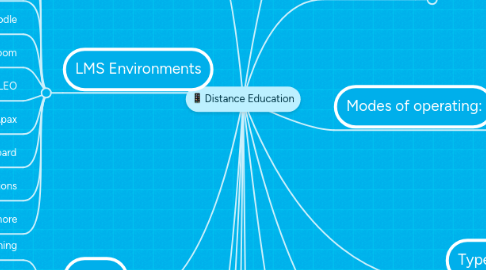Distance Education
by Jacqueline Gardy


1. Is not:
1.1. directly comparable to traditional learning
1.2. new
1.3. alien
2. Learner Profile
2.1. PT students, FT workers
2.2. have more work exp
2.3. usually older
2.4. are upwardly mobile
2.5. have more qualifications
3. Systems view
3.1. Learning, teaching, communication, design, management
4. LMS Environments
4.1. Compass
4.2. Desire2Learn
4.3. Canvas
4.4. Moodle
4.5. Google Classroom
4.6. LEO
4.7. Apax
4.8. BlackBoard
4.9. Connexions
4.10. Lots and lots more
5. Social learning
5.1. EdModo
5.1.1. Facebook
5.1.1.1. Twitter
5.1.1.1.1. LinkedIn
6. Distance Education: Distance education can be many things: it can be a training ground for employees, it can be a degree-granting online university, or it can be a hybrid online high school program. It can also be massive, such as a MOOC, or very personal, as in online English tutoring. It can be crowd-sourced, like https://www.duolingo.com/, or it can be closed to only a particular group of learners, such as this course, or in a professor-led Facebook group. It can reach many that could otherwise not participate and it can provide flexibility to the full-time worker so they can attend class without commuting to a campus.
7. Can:
7.1. update skills
7.2. cut participant costs
7.3. imp;rove quality
7.4. enhance capacity
7.5. balance inequality
7.6. can fit into plans and lifestyles in a different way than traditional LE's
7.7. reach specific audiences
8. Has:
8.1. Generations
8.1.1. Moore and Kearsley:
8.1.2. Gen 1: Correspondence
8.1.3. Gen 2: Broadcast and radio and TV
8.1.4. Gen 3: Open Universitiies
8.1.5. Gen 4: Teleconferencing
8.1.6. Gen 5: Internet/Web
8.2. Otto:
8.3. Gen 1: Traditional Core
8.4. Gen 2: Teleconferencing
8.5. Gen 3: PC, supplements CMC
8.6. Unique qualities
9. What's still needed:
9.1. Support for overcoming learning difficulties specific to DE
9.2. More flexibility
10. Models:
10.1. Correspondence
10.1.1. conversation
10.1.1.1. teacher
10.1.1.1.1. tutor
11. Types:
11.1. Media
11.1.1. text
11.1.1.1. images
11.1.1.1.1. sounds
12. Modes of operating:
12.1. Single mode
12.1.1. Specific to DE
12.1.1.1. Guided self-study
12.2. Dual mode
12.2.1. Traditional
12.2.1.1. Attending teaching events via indirect attendance
12.3. Mixed mode
12.3.1. Autonomous self-guided learning
13. Examples:
13.1. MOOCs
13.1.1. Public university courses
13.1.1.1. Private colleges
13.1.1.1.1. for-profit institution
